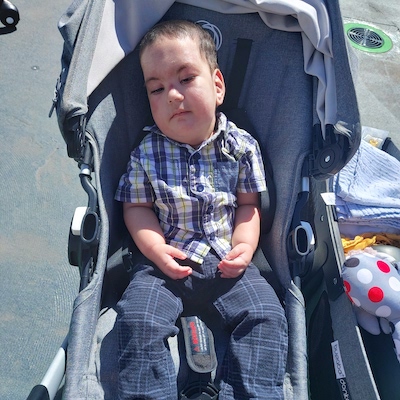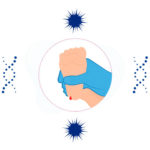Genetic sequencing may open doors for newborns with hypotonia

When a baby is born with low muscle tone (hypotonia), the future is hard to predict, and families have a lot of questions. How should neonatologists care for these infants? Findings from a recent review could help provide some answers, guide appropriate interventions, and in some cases open the way to custom treatments.
Diagnosing a newborn with hypotonia is typically a complex process involving multiple tests and sometimes months of waiting. The review, published in JAMA Neurology, argues in favor of starting with comprehensive DNA sequencing up front, bypassing other testing and cutting down on wait times.
“Standard newborn genetic screening won’t pick up most cases of hypotonia, and most genetic testing after that is piecemeal,” says neonatologist Pankaj Agrawal, MD, MMSc, who directs the Neonatal Genomics Program in Boston Children’s Division of Newborn Medicine and co-led the review. “Infants can undergo different tests and still, after months, have no diagnosis. We thought, why not start with whole-exome or whole-genome sequencing as a first approach when the cause of muscle weakness is unknown?”
This article continues our series on genomic testing in newborns. See our past articles on genetic testing in newborns with congenital heart disease and SIDS and a program that brings genomic testing and interpretation to community NICUs.
The review was conducted by International Precision Child Health Partnership (IPCHiP), a consortium of academic NICUs co-founded by Boston Children’s in 2021. It pooled results from 41 newborns with unexplained hypotonia who had undergone exome sequencing (which covers just the protein-coding genes) or whole-genome sequencing (including other elements such as regulatory factors).
Overall, 56 percent of these newborns received a genetic diagnosis, ranging from 30 to 80 percent among the different centers. Of the 41 newborns, 17 had a change in their care based on the findings, such as expedited tracheostomy or gastrostomy for breathing or nutritional support in babies with a longer predicted life expectancy, allowing them to go home or start rehabilitation sooner. It also helped families understand the risk of the condition in future pregnancies.
From genes to treatments
Two infants in the study had mutations for which there is a targeted treatment. One infant with congenital myasthenic syndrome received acetazolamide, dietary recommendations, and advice to avoid QT-prolonging medications. The other baby received a targeted treatment for mitochondrial DNA depletion syndrome, but unfortunately it was not completely effective.
Genetic conditions that can cause hypotonia
Motor neuron disease (e.g., spinal muscular atrophy)
Chromosomal abnormalities (e.g., Prader-Willi syndrome)
Neurometabolic conditions (e.g., peroxisomal disorders and other inborn errors of metabolism)
Cortical brain malformations
Muscle disorders (e.g., myopathies, muscular dystrophies)
Neuromuscular disorders
“One of our main goals in sequencing is to identify patients who can benefit from early personalized therapies,” says Agrawal. “The most benefit seems to come when children are treated as early as possible.”
Targeted genetic treatments are now available for spinal muscular atrophy, a relatively common cause of hypotonia. Several other conditions, such as MTM1-related myotubular myopathy, aromatic L-amino acid decarboxylase deficiency, giant axonal neuropathy, and metachromatic leukodystrophy, have treatments under development. As Agrawal and his colleagues find new hypotonia genes, they can investigate their workings and explore new treatment approaches.
Case study: SPEG mutations
About a year ago, Agrawal received an email from Syed Nadeem Zia, a father in the U.K. whose infant son, Noyan, had been born with hypotonia. Noyan had been diagnosed with centronuclear myopathy, a rare condition causing muscle weakness, and had been found to have a mutation in the SPEG gene.
Agrawal’s team had identified mutations in the SPEG gene as a cause of centronuclear myopathy in 2014 and subsequently outlined SPEG’s role in muscle function. Most recently, they showed a possible approach to treatment: The SPEG protein interacts with another protein, dynamin-2. When they suppressed dynamin-2 in SPEG-deficient mice, they saw gains in life span, body weight, and motor performance.

Seeing these papers on the internet, Syed put Agrawal in touch with Noyan’s neonatologist, hoping to get some answers virtually.
Reviewing Noyan’s records, and based on his experience with SPEG mutations, Agrawal was able to make suggestions about Noyan’s care. Noyan had chylothorax, leakage of lymphatic fluid into the lung space that sometimes occurs with SPEG mutations. Agrawal provided reassurance that it was unlikely to worsen. He also reassured the care team and family that while a targeted treatment was probably years away, Noyan’s muscle weakness was unlikely to progress and that neurologic complications were unlikely.
The chylothorax resolved, Noyan is now home with a BiPaP noninvasive ventilation system. He receives parenteral nutrition and will be monitored for cardiomyopathy, a frequent complication of SPEG mutations.
“He’s listening and knows what’s going on around him,” says Syed. “The problem is his muscles: He wants to do things — his mind is saying ‘do it’ — but he isn’t able.” But overall, Noyan’s parents are pleased with his development.
Agrawal hopes to find more options for infants like Noyan in the future. He is seeking funding to explore new approaches, such as using mesenchymal stem cells and/or antisense oligonucleotides to strengthen the skeletal and heart muscle in animal models.
Making neonatal sequencing routine
Noyan’s and others’ experiences will also help spare newborns from having to go through long diagnostic odysseys in the future. Based on the IPCHiP study and others, Boston Children’s has introduced protocols and best practices for routine exome sequencing in its NICU. Agrawal and his colleagues are also piloting an NIH-funded program that brings genomic testing and interpretation to community NICUs that lack the resources to pursue such testing on their own — so they can match newborns with genetic conditions like hypotonia with the best possible treatments.
“Now it’s possible to have a diagnosis in two weeks — rather than months — and the family doesn’t have to go through extended pain,” Agrawal says. “There’s a lot more hope now than there used to be.”
Explore the Neonatal Genomics Program.
Related Posts :
-

Newborn genetic screening for pediatric cancer risk could save lives
Numerous genetic mutations increase children’s risk for various cancers. When they are detected early, cancers can potentially be caught ...
-

Solving neurodevelopmental mysteries, one gene, one child at a time
Suheil Day was born early, at 37 weeks. Aside from a slight head lag and mild muscle weakness, nothing seemed terribly ...
-

Optimizing care for bronchopulmonary dysplasia, infant by infant
Preterm newborns with bronchopulmonary dysplasia (BPD) can require ongoing mechanical ventilation to support their lungs. But babies with BPD aren't ...
-

Beyond fluid buildup: Rethinking congenital hydrocephalus
Hydrocephalus is classically seen as a plumbing problem, the result of too much cerebrospinal fluid (CSF) in the brain or ...





